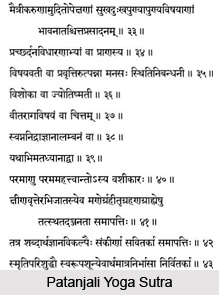 The bahya abhyantara visaya aksepl caturthah sutra speaks about the transcendence in regard to the external and internal pranayama. It travels beyond the limits of just regulation and control of breath. In such a condition, one appears to be as if in a state of suspension. The flow of energy, intelligence and consciousness comes to a standstill, excluding the imperceptible impressions.
The bahya abhyantara visaya aksepl caturthah sutra speaks about the transcendence in regard to the external and internal pranayama. It travels beyond the limits of just regulation and control of breath. In such a condition, one appears to be as if in a state of suspension. The flow of energy, intelligence and consciousness comes to a standstill, excluding the imperceptible impressions.
bahya external
abhyantara internal
visaya region, sphere, an object, reference, aim, realm
aksepl passing over, gaining over, overcoming, transcending
caturthah the fourth
The fourth type of pranayama surpasses the external and internal pranayamas, and appears effortless and non-deliberate.
The fourth type of pranayama goes beyond the regulation or modulation of breath flow and retention, surpassing the methodology stated in the previous sutra. It is a state similar to kevala kumbhaka, which is referred to in the hathayoga texts and in the yoga upanisads.
When the movement of the breath functions without one`s will or effort, the fourth stage of pranayama has been accomplished. The movements of the mind and consciousness ceases. The flow of essential energy, intelligence and consciousness comes to a standstill except for subliminal impressions. This is similar to virama pratyaya, as explained in 1.18. A state of suspension is experienced, in both the breath and the mind. From this springs forth a new awakening and the light of intelligence forcefully imbues the sadhaka`s innermost being.
Since this fourth stage contains no restrictions, it surpasses the range of movements described in the pranayamas of 11.50. It is therefore a `seedless` (nirbija) pranayama.




















